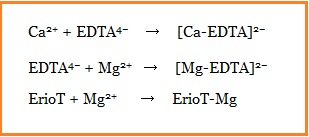Titration is a typical laboratory technique for determining the unknown concentration of an analyte that has been identified. When it comes to goals and processes, different types of titration are used, such as acid-base, precipitation, redox, and complexometric titration.
What is complexometric titration?
Complexometric titration, also known as chelatometry, is a method of volumetric analysis in which colored complexes are used to determine the endpoint of the titration. It is a quantitative chemical analysis approach that is used to quantify metal ions by employing complex-formation reactions.
In this type of titration, the metal ion reacts with the indicator to form the metal indicator complex in this type of titration. Consequently, ethylenediaminetetraacetic acid is introduced, which reacts with the metal ion to form the metal-EDTA complex, which is more stable than the metal-indicator complex.
Thus, the metal-indicator complex breaks down, releasing free metal ions to react with EDTA. Because free metal ions are not present at the equivalent point, the color of the free indicator ion differs from the color of the metal indicator complex.
What is EDTA titration?
EDTA (ethylenediaminetetraacetic acid) is a complexometric indicator made up of two amino groups and four Lewis bases (carboxyl groups). Because of its ability to denote six pairs of lonely electrons caused by the formation of covalent bonds, Edta is a hexadentate ligand.
The presence of even small metal ions will cause a noticeable color change. This results in the formation of a weak complex. The majority of complexing agents are free acids, which are less soluble in water. In volumetric solutions, they are used. They are converted into sodium salts that can be used in water before being used. They are used for titration because of their low solubility in water.
Simple titration methods are sometimes used to determine the presence of simple metal ions in water. However, complexometric titration with EDTA is performed to identify the precise number of metal ions present in the sample.
How does EDTA complexometric titration work?
In water, EDTA or its sodium salt forms a stable complex ion with the hardness-producing ions Ca2+ or Mg2+. The titration is performed in the presence of an indicator like eriochrome black (EBT).
The total hardness of a hard water sample can be measured by titrating Ca2+ and Mg2+ contained in an aliquot of the sample with a Na EDTA solution, utilizing ammonium chloride (NH4Cl), a pH = 10 ammonia (NH4OH) buffer solution, and the metal indicator EBT. In hard water, the EBT indicator forms a wine-red, unstable combination with Ca2+ or Mg2+ ions at pH 10.
As EDTA from burette is added to the wine red complex, a more stable Ca-EDTA complex is formed, although it is colorless. When all Ca2+ ions have complexed with EDTA near the endpoint, indicator EBT ions break out, which turns the solution blue.
Indicator used in EDTA complexometric titration:
To determine the endpoint of metal cation titrations using EDTA, a complexometric indicator is required. For this purpose, a blue dye called Eriochrome Black T (EBT) is most commonly used as an indicator.
Organic dyes such as eriochrome black t, fast sulphon black, eriochrome red b, Patton Reeder, or murexide are common indications. When the endpoint is reached, the indicator is displaced from the metal cations in the solution, resulting in a color change. Thus, the free indicator acts as the endpoint indicator.
Types of EDTA titration:
EDTA titration is classified as direct, indirect, back, and displacement titration.
Direct titration:
The direct method of complexometric titration is the most basic titration process that involves the use of a metal-salt solution titrated with a complexing compound solution (Reaction between unknown compounds with a titrant of known concentration).
Indirect titration:
It involves the process of reacting the solute with moles of a particular excess reagent and thereby titrating this reagent with a second reagent. It applies to compounds having aluminum or bismuth or mercury.
Black titration:
It involves an excess of EDTA being added to the metal ion solution, and after that, the excess of EDTA being titrated with a known concentration of a second metal ion.
Displacement titration:
The excess second metal bound to EDTA is used to titrate the analyte. The second metal in the EDTA complex is displaced by the analyte ion.
Applications of EDTA titration:
- It is used to determine how many metal ions are in a solution.
- It is used to determine the hardness of the water.
- It is used to determine the amount of calcium in food products.
- It is used to find out how many harmful metals are in the environment.
- It is used for the assay of different types of drugs, such as aluminum hydroxide.
Frequently Asked Question (FAQ):
Why do we use EDTA in titration to calculate hardness?
The hardness of an unknown water sample can then be determined using the EDTA solution. EDTA is added since is insoluble in water and it will complex to free Ca2+ and Mg2+ ions, leaving the MgIn– complex alone until almost all of the calcium and magnesium have been converted to chelates., hence the disodium salt of EDTA is taken for this experiment.
Why is EBT used in EDTA titration?
Because it forms a complex with calcium, magnesium, and other metal ions in its protonated form, eriochrome black T is used as a complexometric titration indicator. The metal ions complexed with eriochrome black T react with the EDTA to form a blue color when titrated with EDTA.
What is a complexometric titration example?
The estimation of water hardness using EDTA and Eriochrome Black-T as the indicator is one example of complexometric titration.
References:
- “Complexometric Titration - Wikipedia.” Complexometric Titration - Wikipedia, en.wikipedia.org, Available Here:
- Modern analytical chemistry-David Harvey. Available Here:
You may also like this:

No comments:
Post a Comment